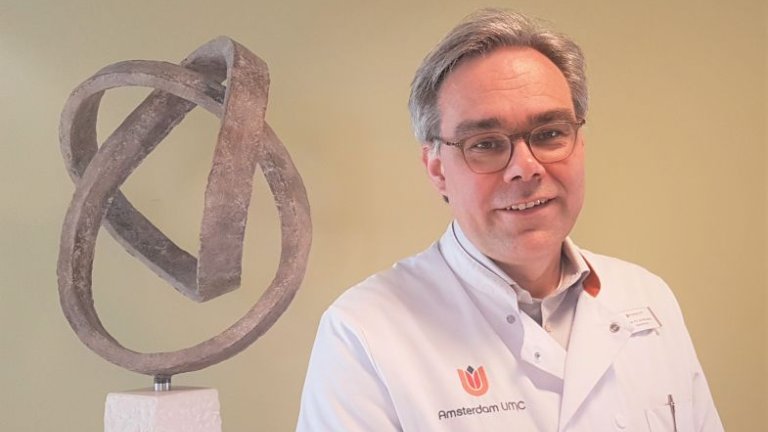As a neurosurgeon, Philip de Witt Hamer knows better than anyone that he is in a field of research with few breakthroughs. But that doesn't mean he should sit still in his Translational Brain Tumor Research chair. In fact, he is a pioneer in devising new techniques and therapies for patients with brain cancer. On Friday March 18, Professor the Witt Hamer presented his vision and ambitions on patient care, research, and education in his inaugural
lecture.
Brain tumors often affect younger people, and unfortunately they often also die young. That is why Prof. De Witt Hamer is keen to help his patients in any way he can. When a primary brain tumor is diagnosed, the patients are actually already in a palliative phase of care.
“However, there is a significant delay in the course of the disease with today's treatments. It depends on the aggressiveness of the tumor. With surgery, radiation and chemotherapy, we can usually slow down the disease,” says Prof. De Witt Hamer. “Brains are a vulnerable organ when a brain tumor grows into it, and there are important limitations for treatments.”
Nevertheless, the neurosurgeon believes in keeping a larger perspective and refers to the symbolism of Maurits Escher's Knots, an infinite or trefoil knot. For him, this image accurately reflects the patient's concerns: good care, good quality of life, and a life that lasts as long as possible.
Good care
According to Philip De Witt Hamer, good care is about partnerships: With the patient, with the treatment team with representatives from six disciplines, with the oncology section of the Dutch Association for Neurosurgery, with the National Working Group for Neuro-Oncology, and with a collective of neurosurgeons around the world, in collaboration with radiotherapists and neuroradiologists.
The latter group, the Picture Team, studies patient data and brain scans from daily practice on a large scale in search of new patterns and areas for improvement. “There is quite a bit of variation in practice, for example, in decisions about when to do only a biopsy or when to remove the tumor. We are developing artificial intelligence to simplify this complex decision-making process about brain tumor operations, and hopefully this will contribute to better care,” explains Prof. De Witt Hamer.
Thinking outside the box
The second point of attention is a good quality of life. Patients with a brain tumor in a stable phase often suffer from fatigue, anxiety and depression, and concentration problems which negatively impacts their quality of life. Prof. De Witt Hamer and his Gripteam are initiating five randomized clinical studies based on innovative ideas from “outside the box”. One study called ‘GRIP op vermoeidheid’, literally translated as ‘grip on fatigue’, are looking at whether cognitive behavioral therapy reduces fatigue.
“We are also looking at medicinal cannabis,” says Prof. De Witt Hamer. “We want to know whether anxiety and depression can be reduced by treatment with medicinal cannabis, as many patients convey.” He and his team suspect that cannabidiol may improve well-being. To find out, they compare the effect of cannabidiol tablets with a placebo in their study. The researchers expect the results of the study in a few years' time.
Another innovative study is magnetic stimulation to improve attention and poor concentration. Prof. De Witt Hamer explains: “We want to see if we can improve concentration problems by strengthening the healthy parts of the brain with magnetic pulses.”
Long live, long breathe
The third dimension of the trefoil knot is longevity. As a researcher, you really have to be patient, says Prof. De Witt Hamer. Operations, radiation, and chemotherapy all help, but research into new medicines moves slowly. Philip De Witt Hamer experienced this himself, following a discovery in his PhD research. The inhibition of a kinase enzyme showed promise for brain tumors, but fourteen years after this discovery, the effectiveness in patients is still unknown. However, researchers in the United States did find that the inhibitor reaches the brain tumor well and the side effects in combination with standard treatment will soon be known.
In the past generation, only two randomized phase III studies of glioblastoma treatment worldwide have shown improvement in survival times. One study added chemotherapy tablets to the standard treatment. The other study used scalp stickers that deliver alternating electric currents called tumor-treating fields. This did have a tumor-inhibiting effect but has not become a new standard of treatment. “Why shouldn’t we, as neurosurgeons, apply electricity inside the brain, as we have been doing for years for patients with other brain disorders, such as Parkinson's disease? If we've partially removed the tumor, it's only a small step to apply electrical fields to inhibit the tumor. But first, we want to make sure that this is safe enough for our patients with a brain tumor,” says Prof. De Witt Hamer. “Of course, we will keep looking.”
Another line of research in development is studies using radioactive isotopes to fight the tumor. The first steps have been taken with PET brain scans in patients with a tracer to adhere to radioactive isotopes, which are thus lured to the tumor, in collaboration with the Department of Radiology and Nuclear Medicine.
Bringing knowledge together
By collaborating with various groups nationally and internationally, Prof. De Witt Hamer shares knowledge in order to accelerate breakthroughs and find the best treatment methods for the patients of tomorrow. He is pleased with the start of the construction of the Research & Diagnostic Center ADORE, where researchers from different knowledge domains will come together in pursuit of new insights and ideas. “I believe in that by asking each other the right questions, we can accelerate progress. I believe that breakthrough for brain tumors is also coming!”

For more information, contact Prof. Philip de Witt Hamer
Text and pictures by Daniëla Cohen / English translation Laura Roy

